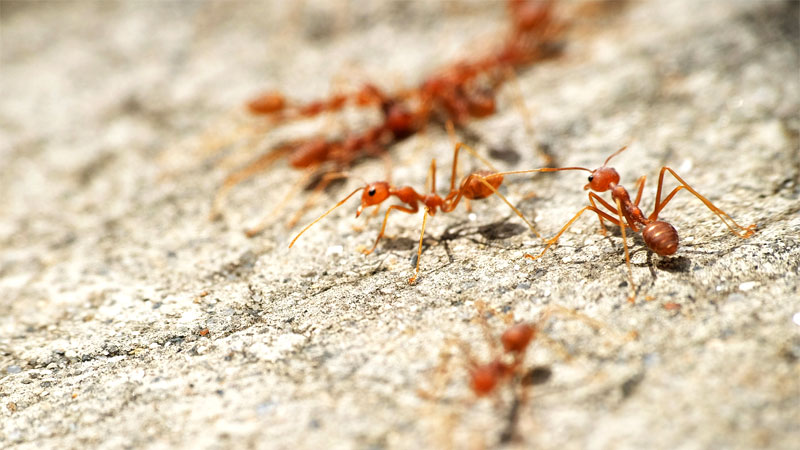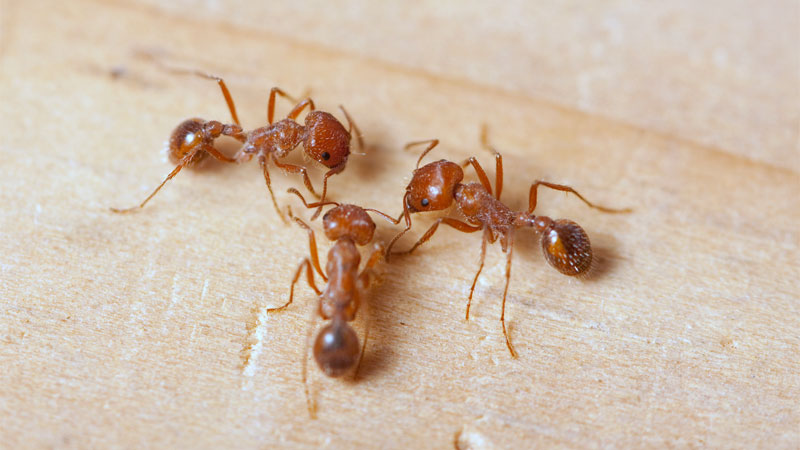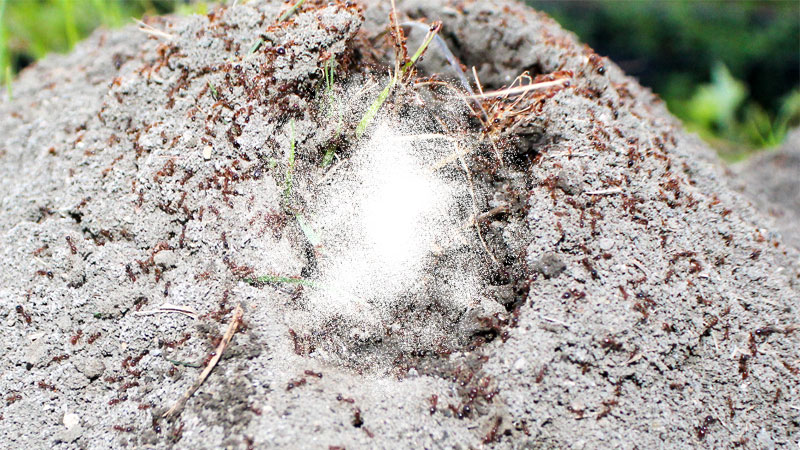We cover a lot of invasive species here at RMC, but fire ants are among the more dangerous.
When you find one of their mounds in your garden or lawn, it’s important to get rid of the fire ant hill ASAP before the fire ants can wander into your house or start biting your family.
We’ve therefore tested four fire ant-specific products in-house to see if their consumer reviews are accurate.
Here’s what we’ve learned.
Related: Best Ant Bait Traps for Your Home
Fire Ants 201: What You NEED to Know Before Using Products
Morgan covered fire ants in more detail before, but there are a few things we must review before talking about products.
These things can make all the difference between successful chemical warfare and total failure.
Reminder 1: BIFA vs RIFA vs Natives
Overall, there are around 20 accepted species of “true fire ants” in the genus Solenopsis.
This is the same genus that thief ants come from, and fire ants are often considered to be sugar ants.
When dealing with native species, you can attack their colonies same way you would Argentine ants or pavement ants.
However, BIFAs and RIFAs must be handled differently (and more carefully).
Red imported fire ants (Solenopsis invicta), or RIFAs, are highly aggressive and can be found in many southern states.
Black imported fire ants (Solenopsis richteri), or BIFAs, are more cold hardy, (slightly) less aggressive, but have not spread outside of Alabama, Mississippi, and Tennessee.
Both species have black males and female workers that come in a variety of shapes and sizes but are generally yellowish with a brown to black abdomen.
Reminder 2: Imported Fire Ant Nesting Habits
Both RIFAs and BIFAs have multi-queen colonies.
They make visible ant hills, but the colony is spread out beyond the mounds with a radius of up to 25 feet.
Even worse, both species are attracted to electrical currents and will often nest among wiring or in junction boxes.
If you don’t fight smart, the queens will survive and begin breeding even faster as a response to the threat to their colony.
Reminder 3: The Pain Factor
You can’t just go after the nest, due to the risk of bites is high.
A single fire ant bite only ranks one on the Schmidt scale, which is the same as a bumblebee sting.

But you won’t get bitten by just one RIFA or BIFA.
Instead, these little critters will swarm you like zombies at an all-you-can-eat brain barbecue.
Read Also: 12 Types of Ant Mounds (with Pictures)
Bringing it Together
As you can see from these three facts, you can’t just go after an imported fire ant nest with any old remedy.
Also, due to the size of the nests, you need to use methods that can get to the ants deep underground.
The fire ant control products we’ve included here are all designed specifically for controlling BIFAs and RIFAs.
Our 4 Top Fire Ant Killers
There are a lot of products out there that can eliminate fire ants according to the product label, but a lot of them are a waste of money.
It doesn’t help that ant mound treatments aren’t necessarily effective against the entire colony.
Here are four fire ant-specific products we’ve tested that proved highly effective, as well as our findings.
#1 – Ortho Orthene Fire Ant Killer
- Kills the queen and destroys the mound
- No watering-in required
- Treats 54 mounds
Ortho has an excellent reputation, especially for their Home Defense line.
We really loved using Ortho Orthene, because this product is easy to use and quite effective.
Just like borax and diatomaceous earth, Orthese granules are a surface treatment.
When sprinkled on fire ant mounds, the granules won’t alarm the ant colony.
It’s also safe for use in lawns and gardens.
The formula contains organophosphates, neurotoxins that paralyze and eventually kill the ants that consume it.
However, since the effects aren’t instantaneous, workers are able to take it back to the queens, effectively killing the entire colony over time.
Pros:
- Long-lasting formula (lasts up to 6 months)
- Fast-acting
- No need to dilute the granules
Cons:
- Has to be poured directly onto the mount
- Organophosphates are highly toxic to humans and pets
Note that we were so impressed with this particular product we did a full review of it.
#2 – Martin’s Surrender Fire Ant Killer
- Can not ship to AK, AZ, CA, CO, CT, DE, DC, HI, ID, IL, IN, IA, KY, ME, MD, MA,...
- States Registered: AL, AR, FL, GA, KS, LA, MS, NC, NM, OK, SC, TN, TX, VA, WV
- Surrender Fire Ant Killer is for control of imported fire ants and harvester...
You might not have heard of Martin’s (a brand from Control Solutions, Inc.), but that doesn’t mean this isn’t a great mound treatment.
You can either use it in its pure powder form or diluted in water as a drench.
For our own test, we stuck with the powder form, which can simply be sprinkled onto the mound.
The product label claims it’s good for an entire season, will treat up to 108 mounds, and can also be used against harvester ants.
Note that the active ingredient in this one is acephate, an organophosphate that’s fairly safe if used properly.
One rule for safe use is that it shouldn’t be used as a blanket treatment on turfgrass unless it’s a golf course or similar area.
This isn’t made clear on the front of the label, which worried us, but you can still safely use it as a spot treatment for mounds on your lawn.
Keeping this in mind, we found the product worked quickly and efficiently
Pros:
- Fast-acting and effective
- Only needs to be applied once per season
- The product has a long shelf life.
Cons:
- The smell can be a little off-putting.
- Toxic to humans, pets, and birds if used incorrectly
If you choose to use Martin’s Surrender, we strongly urge you to read the EPA documentation on acephate that we linked to above.
It will tell you how to use the product safely and with minimal risk to your family or the environment.
#3 – Advion Fire Ant Bait
- Advion fire ant bait effective and fast acting. Combined with an alluring...
- Broadcast or mound treatment
- Recreation areas as well as institutional or private service areas
Advion isn’t as well-known as Raid or Ortho, but that doesn’t mean they don’t have a growing reputation for excellent pesticides.
We’ve already tried granules and a powder, so this time it was a bait product.
The active ingredient for this one is indoxacarb, which was originally approved by the EPA as a safer substitute for organophosphates in multiple commercial crops.
Of course, it’s still toxic to humans and pets if misused.
Because of its lower toxicity and the tiny amount present in the bait, you can use this product both directly on the mound and on the surrounding lawn.
Advion claimed the bait would kill the colony in 72 hours or less, and they weren’t kidding.
As we’d planned to spend a week at each field location, I actually had a few free days to play tourist!
Pros
- Highly effective, safer (when used responsibly) and proven formula.
- Can eliminate an entire fire ant colony in 24-72 hours
- Bait targets a number of pest ants
Cons
- More expensive than a lot of similar products
- May require a spreader to cover the lawn
#4 – BioAdvanced Fire Ant Killer Dust

One thing we should note right now is that the active ingredient in this one is beta-cyfluthrin, which the EPA has found to be highly toxic.
That’s not to say you can’t use this product safely, but it does mean it’s banned in the usual states.
Application is just two shakes of the container over your target mound and it gets to work immediately.
This was another one that only took a few days to wipe out the entire nest, but Morgan’s team was doing the test, so he had the extra vacation this time.
One package will take out up to 130 mounds, with a regular sized mound taking two shakes and large mounds taking four.
Pros:
- Almost completely odorless.
- Easy to use
- Can wipe out a fire ant colony in 3 days or less.
- Good shelf life and value for the price
Cons:
- Not for sale in some states
- Very fine dust that can’t be safely applied on windy days
- How to Identify Skunk Poop (With Pictures) - April 1, 2024
- You Really Don’t Need That Opossum Trap - January 4, 2024
- How to Set a Mouse Trap Without Getting Hurt - December 28, 2023







